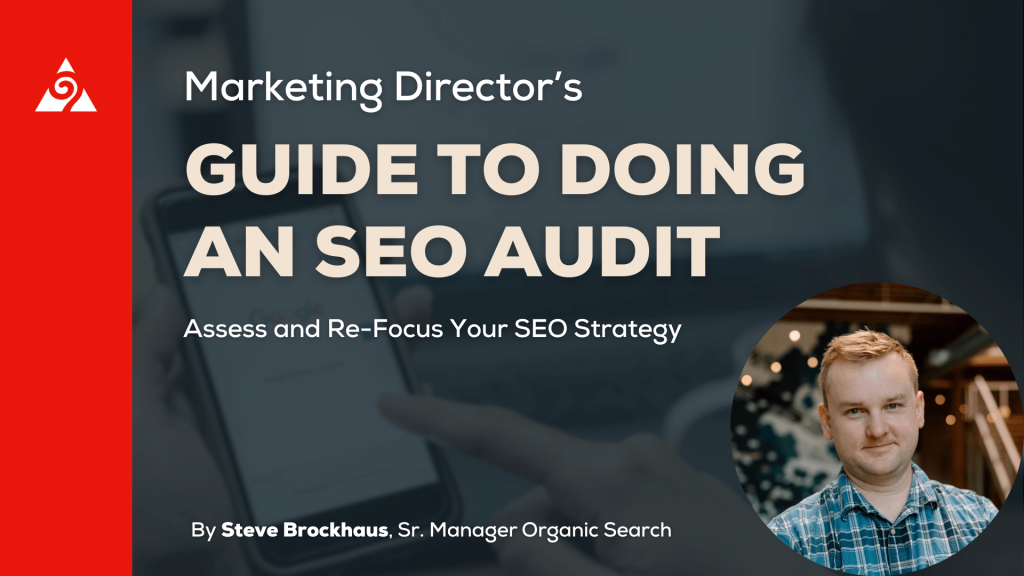You’re here because you need to assess and re-focus your SEO strategy.
When developing a comprehensive digital marketing plan, a well-crafted SEO strategy is not just a nice-to-have—it’s a critical component of your marketing arsenal.
In digital marketing, Search Engine Optimization (SEO) is a cornerstone for ensuring your brand’s visibility and online success. However, for many marketing directors, especially those leading a small team, SEO can seem like a complex and ever-changing puzzle.
“How much organic traffic are we missing?”
With limited resources and a high demand for results, the pressure to perform is intense. So, we’ve tailored this guide for marketing directors who want more than a checklist.
- Why Routine SEO Audits Are Important
- Benchmarks for SEO Performance
- Using Benchmarks to Find Areas for Improvement
- How to Conduct a Preliminary Website SEO Audit
Understanding SEO Basics
Sharpening up your SEO strategy begins with a deep understanding of the basics, recognizing the common pitfalls that small marketing teams face, assessing and benchmarking your current performance, and then understanding how you stack up against your competition.
It involves equipping yourself with the knowledge to conduct preliminary health checks and understanding the transformative power of regular SEO audits.
Each element is vital in crafting a strategy that meets and exceeds your stakeholders’ expectations.
SEO’s Role in Digital Marketing: Going Beyond Keywords
At its core, SEO is about connecting with your target audience by showing up at the top for their searches. It’s not about sprinkling your content with keywords. It is about understanding the intent behind those keywords—what your potential customers are really looking for.
SEO involves optimizing your website’s structure, content, and performance to ensure it meets users’ needs and search engine criteria.
- User Experience (UX): A well-optimized site provides a seamless, engaging user experience. A good user experience for SEO includes fast loading times, mobile responsiveness, and intuitive navigation.
- Content Relevance: Your site’s content needs to answer the questions your audience is asking and provide value that goes beyond the superficial.
- Authority and Trustworthiness: You can build a reputable online presence through quality backlinks and internal linking, provide helpful information, and encourage user engagement. SEO auditing tools can compile a complete backlink profile to discover all websites that refer to yours.
- Technical SEO: Ensuring proper site architecture, identifying broken pages, reviewing internal and external links to allow for the flow of link equity to all the pages, reviewing title tags and meta descriptions, removing duplicate content, and optimizing site speed.
By identifying and addressing these SEO pillars, your small marketing team can develop more effective SEO strategies that drive growth and enhance your competitive edge.
The Importance of Routine SEO Audits
For marketing directors aiming to stay competitive and meet the high expectations set by company leadership, regular SEO audits are not just beneficial—they’re required.
An SEO audit is a comprehensive examination of your website’s adherence to best practices for search engine optimization. It’s the first step in identifying the SEO issues hindering your site’s SEO performance.
Spotting Emerging Issues Before They Impact Your Rankings
Search engines like Google continuously update their algorithms to improve the relevance and quality of search results. What worked for SEO last year—or even last month—may not work today.
SEO site audits allow you to…
- Spot Technical Problems. Broken links, slow-loading pages, under-optimized images, and other issues can negatively affect your site’s user experience and search engine rankings.
- Make Sure Your Content is Relevant. An audit can reveal outdated content that no longer meets the needs or interests of your target audience, allowing you to update or create new content that better addresses their queries.
- Monitor Your Backlink Health. Links from other websites to yours (backlinks) are a key ranking factor. Audits can help identify and remove harmful backlinks that could penalize your site.
- Adapt to Algorithm Changes. Google’s algorithm updates can significantly impact your site’s visibility in search results. Regular SEO audits help ensure your site complies with the latest search engine guidelines and best practices, protecting it from potential penalties and keeping it competitive in search rankings.
- Know How Your Baselines Compare. SEO audits should include reviewing your competitors’ SEO strategies. This research can provide valuable insights into new gaps or opportunities in the search landscape that you can incorporate into your strategy.
How To Start an SEO Audit
It can initially seem overwhelming, but there are a few easy steps to start. SEO audits always begin with assessing your site’s current organic traffic levels. Once you record your baseline levels, you dig into historical trends to identify any issues or opportunities to help grow your site’s organic presence.
Benchmarks for Assessing Current SEO Performance
As a small marketing team aiming for growth and establishing your company as an industry leader, it’s pivotal to understand how to assess your current SEO performance. Knowing where you stand is the first step in identifying areas for improvement.
Being ranked first for a high-value target keyword does not happen overnight. This section outlines key benchmarks and metrics that marketing directors like you should use to gauge your SEO success and areas that may require a closer look.
SEO Key Performance Indicators (KPIs) to Monitor
SEO effectiveness can be measured using various metrics, each offering insights into different aspects of your strategy.
It’s a good idea to monitor these essential SEO KPIs regularly:
- Organic sessions are the number of visitors arriving at your site through search engine results. An increase in organic traffic indicates that your site is gaining visibility and relevance for your target keywords.
- Keyword rankings are the position of your website in search engine results pages (SERPs) for specific keywords. Tracking changes in rankings can help you understand the effectiveness of your content and keyword strategies.
- Click-through rate (CTR) is the percentage of users who click on your site after seeing it in the search results. A low CTR with high impressions might indicate that your titles and meta descriptions could be more compelling.
- Conversion Rate is the percentage of visitors who take a desired action on your site, such as filling out a contact form or purchasing. This metric helps gauge the effectiveness of your SEO in driving not just any traffic but relevant and valuable traffic.
- Industry Benchmarks are how you measure up against competitors. Compare page speed, the number of ranked keywords, and the number of pages ranked in Google search results to understand how your baselines fit in the landscape.
Understanding how your SEO performance compares to industry standards and competitors is vital for identifying where you stand in the digital landscape.
Here are two ways to benchmark your performance:
- Competitive Analysis tools like SEMrush and Ahrefs allow you to compare your website’s performance with your competitors, including keyword rankings, organic traffic, and backlink profiles.
- Industry Averages: Research industry reports and case studies to find average metrics for businesses like yours. Industry averages can help set realistic goals and expectations for your SEO efforts.
Leveraging SEO Benchmarks to Identify Areas for Improvement
With these benchmarks in hand, small marketing teams can pinpoint specific areas of their SEO strategy that need attention. For example, if your organic traffic is growing but your conversion rate remains low, this indicates that you’re attracting visitors who aren’t interested in your offerings or that your website needs to be more effective in encouraging them to take action.
A Quick SEO Health Check
For marketing directors overseeing small teams, conducting a preliminary SEO health check is crucial in identifying and addressing potential gaps in their SEO strategy. This initial assessment helps lay the groundwork for a more detailed audit and subsequent optimizations, ensuring that efforts are aligned to drive growth and maintain competitive advantage.
Here’s how to start a simple health check of your SEO strategy.
Simple Steps to Identify Obvious Gaps
Even without deep technical SEO knowledge, there are straightforward steps you can take to uncover potential issues that may be affecting your site’s performance in search results:
- Check for Site Indexation. Use the “site:yourdomain.com” search on Google to see how many of your site’s pages are indexed. If the number is significantly lower than the total number of pages on your site, there may be indexation issues.
- Test Your Site Speed. Page speed is crucial for user experience and SEO. Tools like Google’s PageSpeed Insights can provide insights into how quickly your site loads and offer recommendations for improvement.
- Check for Mobile Friendliness. With the increasing prevalence of mobile searches, ensuring your site is mobile-friendly is non-negotiable. Google Chrome’s Lighthouse tool can tell you whether your site meets the criteria for mobile optimization.
- Examine Your On-Page Signals. Look at a few key pages on your site to ensure they have optimized title tags, meta descriptions, and header tags – and that images have descriptive alt attributes. These elements are foundational for on-page SEO and can help improve the accessibility of your site.
Helpful SEO Analysis Tools
Many tools are available to analyze your site’s SEO health more deeply. These tools can provide more detailed insights into areas that need attention:
Google Search Console is a free tool from Google that offers valuable data about your site’s search performance, including issues with indexation, mobile usability errors, average keyword rankings, and opportunities to improve your site’s visibility in search results.
Platforms like SEMrush, Ahrefs, and Moz offer SEO audit features that automatically scan your site for common SEO issues, such as broken links, missing alt tags, and more. These tools often provide actionable recommendations for fixing identified problems.
Understanding how your target keywords perform is essential. Tools like Google’s Keyword Planner or SEMrush can help identify which keywords your site is ranking for – and which are ripe for optimization.
Conducting a Preliminary SEO Site Audit (GSC, GA4, and Beyond)
Even without deep technical expertise, marketing directors can conduct a preliminary SEO audit to spot apparent gaps.
Google Analytics (GA4):
Establish your current baseline for organic traffic and conversions.
- Call up the past 28 days to see how many organic engaged sessions occurred.
- Then, compare this traffic number to the previous 28 days (month-over-month), seeing if the total amount of traffic dropped or increased.
- Then compare it to the same period from last year (year-over-year).
- After recording these, repeat that with a 90-day timeframe and a full 12 months.
This quick analysis will show traffic trends for the entire year and if your site is growing or shrinking in organic traffic. This view below) shows us a site that has experienced a significant surge in organic traffic over the past 12 months.
If you see any unusual traffic trend, the next area to check would be the “pages and screens” report. This view will tell you exactly what pages experienced traffic loss or gain in a given timeframe. From here, you can look for irregularities and trends.
- Did you have one blog post that was bringing in lots of traffic and suddenly stopped?
- Are you PDP page visits dropping?
- Did your most valuable landing pages experience a sudden drop in search traffic?
- Did the average session duration decline for the entire site?
After identifying how many pages are affected by a drop (or gain) in organic traffic, you can proceed to the next step in the site audit. Note: If set up correctly, GA4 will also have conversion data, which should help you gauge your overall site performance.
Google Search Console:
One of the best SEO audit tools is Google Search Console. GSC gives you access to data points, allowing you to see how well your site performs in Google search (though not other search engines like Bing).
Google Search Console’s robust toolset will let you see how many of your pages it’s indexing, how often it crawls your site maps, the status of your core web vitals, your average keyword rankings, and much more. One of the best parts about this free SEO tool is that it will give you data from all your pages – and you can also drill down to see metrics from a single page.
Within Google Search Console, you can also see how many clicks and impressions your site drives from Google over a given timeframe. This chart (below) shows the Google Search performance from a site looking at the past 90 days compared to the same time frame from the previous year. Here, you can see a good growth from 33,800 clicks last year to 51,800 this year.
At the same time, you can see a big jump in both search impressions – 4.9 million to 7.39 million, and a big jump from an average position of 40 to 29. These are signs that a targeted SEO strategy is working. The average click-through rate remaining unchanged at 0.7% represents an opportunity to update page titles and meta descriptions to improve overall CTR.
Google search console will also give you valuable information on how often and effectively Google crawls your site. Calling up the “pages” view will show you how many of your site’s pages are in Google’s index.
During this part of your SEO audit, your goal is to ensure that all pages you intend to generate search traffic with are being found and included in the index. Here is where you can identify issues with 404s, duplicate content, and canonical issues and find technical problems that could be causing Google not to show your content in search results.
Actionable Insights from Preliminary Checks
The insights gained from a preliminary SEO health check can help inform your broader SEO strategy. For instance, if you find that search engines do not fully index your site, you may need to investigate and resolve issues. These could be improper use of robots.txt or noindex tags. If you find page speed is lacking, you might prioritize technical optimizations to improve load times.
Addressing these initial findings can significantly improve your site’s SEO performance. However, it’s important to remember that SEO is an ongoing process. Regularly scheduled, comprehensive SEO audits are necessary to adapt to algorithm updates, evolving best practices, and the competitive landscape.
After Completing an Initial SEO Audit, What’s Next?
Following the preliminary health check, you should prioritize the most critical issues for immediate action. Plan for a detailed SEO audit to dive deeper into your strategy, identifying more nuanced opportunities for improvement.
After identifying all actionable issues on your site that you can fix, a competitive analysis should follow next to see how your site is doing compared to your rivals. You can use tools like SEMrush, Ahrefs, and Moz to create a complete competitive analysis report.
This proactive approach to SEO health ensures that your marketing efforts align with current best practices and are primed to drive sustained growth and competitive advantage in the digital marketplace.
- Marketing Director’s Guide to Doing an SEO Audit - March 20, 2024










